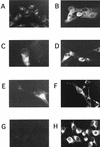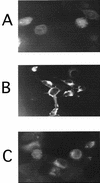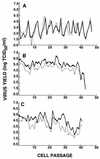Persistent infection of human oligodendrocytic and neuroglial cell lines by human coronavirus 229E
- PMID: 10074187
- PMCID: PMC104097
- DOI: 10.1128/JVI.73.4.3326-3337.1999
Persistent infection of human oligodendrocytic and neuroglial cell lines by human coronavirus 229E
Abstract
Human coronaviruses (HuCV) cause common colds. Previous reports suggest that these infectious agents may be neurotropic in humans, as they are for some mammals. With the long-term aim of providing experimental evidence for the neurotropism of HuCV and the establishment of persistent infections in the nervous system, we have evaluated the susceptibility of various human neural cell lines to acute and persistent infection by HuCV-229E. Viral antigen, infectious virus progeny and viral RNA were monitored during both acute and persistent infections. The astrocytoma cell lines U-87 MG, U-373 MG, and GL-15, as well as neuroblastoma SK-N-SH, neuroglioma H4, and oligodendrocytic MO3.13 cell lines, were all susceptible to an acute infection by HuCV-229E. The CHME-5 immortalized fetal microglial cell line was not susceptible to infection by this virus. The MO3.13 and H4 cell lines also sustained a persistent viral infection, as monitored by detection of viral antigen and infectious virus progeny. Sequencing of the S1 gene from viral RNA after approximately 130 days of infection showed two point mutations, suggesting amino acid changes during persistent infection of MO3.13 cells but none for H4 cells. Thus, persistent in vitro infection did not generate important changes in the S1 portion of the viral spike protein, which was shown for murine coronaviruses to bear hypervariable domains and to interact with cellular receptor. These results are consistent with the potential persistence of HuCV-229E in cells of the human nervous system, such as oligodendrocytes and possibly neurons, and the virus's apparent genomic stability.
Figures




References
-
- Arbour, N., and P. J. Talbot. 1998. Unpublished data.
-
- Barnett E M, Perlman S. The olfactory nerve and not the trigeminal nerve is the major site of CNS entry for mouse hepatitis virus, strain JHM. Virology. 1993;194:185–191. - PubMed
Publication types
MeSH terms
LinkOut - more resources
Full Text Sources
Medical

